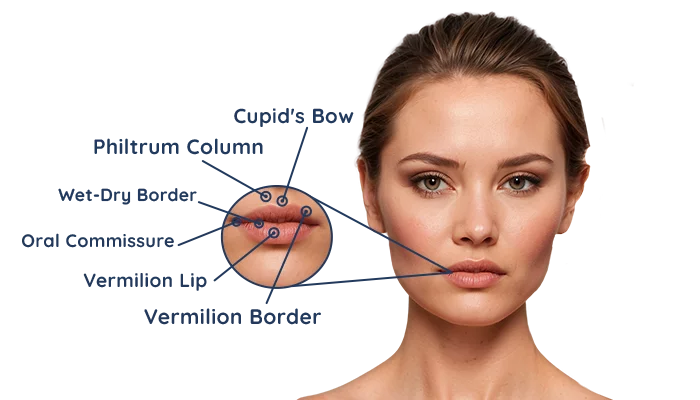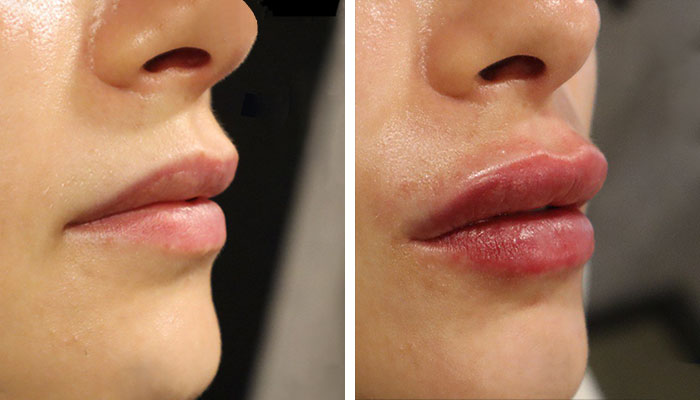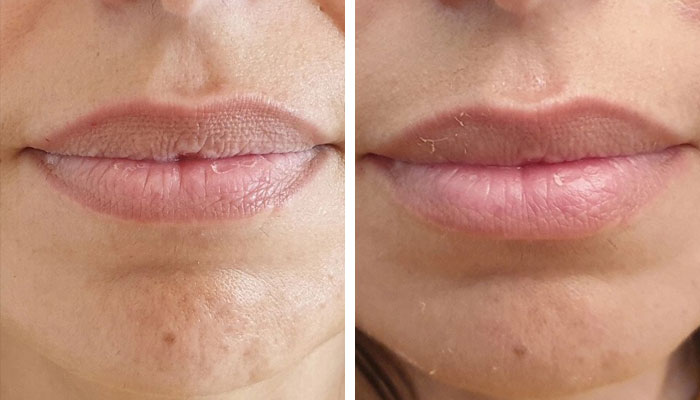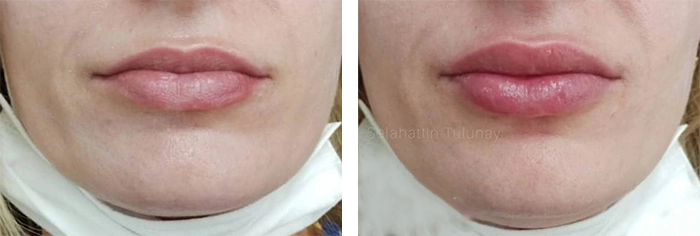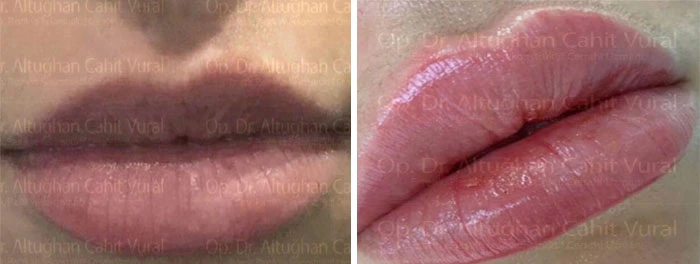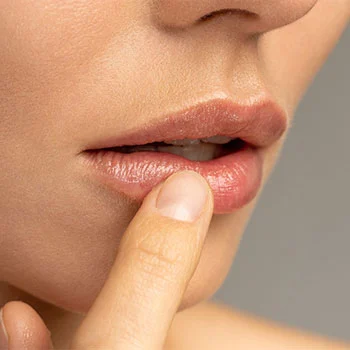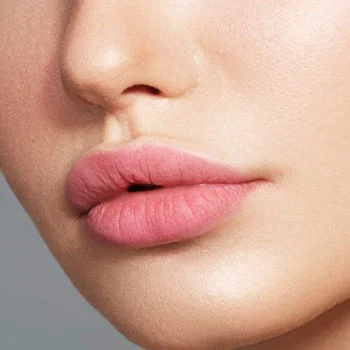What are lip fillers?
Lip fillers, also known as lip augmentation or lip injections, are cosmetic procedures that involve injecting dermal fillers into the lips to enhance their size, shape, and overall appearance. Dermal fillers used for lip augmentation are typically made of hyaluronic acid (HA), a naturally occurring substance in the body that helps retain moisture and adds volume.
During the procedure, a trained medical professional will carefully inject the filler into specific areas of the lips to achieve the desired result. The amount of filler used and the injection technique will depend on the individual's goals and the recommendations of the practitioner.
What are the benefits of lip fillers?
Lip fillers, also known as lip augmentation or lip injections, offer several benefits for individuals seeking to enhance the appearance of their lips. Some key benefits include:
- Increased lip volume: Lip fillers can add volume and plumpness to thin or naturally small lips, resulting in a fuller and more voluminous appearance. This can help create a more youthful and attractive look.
- Improved lip shape and definition: Lip fillers can enhance the shape and contour of the lips, addressing asymmetry, unevenness, or irregularities. They can help achieve a more balanced and aesthetically pleasing lip shape, enhancing facial harmony.
- Reduction of fine lines and wrinkles: Lip fillers can help minimize the appearance of fine lines and wrinkles around the lips, often referred to as "smoker's lines" or "lipstick lines." By filling in these lines, lip fillers can create a smoother and more youthful appearance.
- Customizable results: Lip fillers offer a high level of customization. The amount and placement of the filler can be tailored to meet the individual's desired outcome. This allows for personalized results that align with the person's specific goals and facial features.
- Non-surgical procedure: Lip fillers are a non-surgical cosmetic treatment. This means they can be performed as an outpatient procedure, typically requiring only minimal downtime and recovery. Compared to surgical lip augmentation procedures, such as lip implants, lip fillers offer a less invasive option with fewer associated risks.
Who are lip fillers suitable for?
Lip fillers are suitable for a range of individuals who desire to enhance the appearance of their lips. They may be appropriate for:
- Individuals with thin lips: Lip fillers can add volume and fullness to thin lips, providing a more plump and balanced appearance.
- Those with naturally small lips: Some individuals may have naturally small lips that they wish to enhance for a more prominent and defined look.
- Individuals with lip asymmetry: Lip fillers can help address asymmetry or unevenness in lip shape and volume, creating a more symmetrical and harmonious appearance.
- Those with age-related lip changes: As we age, our lips may lose volume and develop fine lines and wrinkles. Lip fillers can restore lost volume, smooth out wrinkles, and rejuvenate the lips.
- Individuals with lip shape concerns: Lip fillers can be used to reshape the lips, improving their contour, definition, and overall shape. This is beneficial for individuals who are dissatisfied with the natural shape of their lips.
- People looking for temporary enhancements: Lip fillers offer temporary results, which can be appealing for those who want to experiment with different lip enhancements or desire the flexibility to adjust their appearance over time.
It is important to note that the suitability of lip fillers for an individual may depend on factors such as overall health, specific lip anatomy, and any underlying medical conditions. It is recommended to consult with a qualified medical professional who specializes in cosmetic procedures to determine if lip fillers are suitable for your specific needs and goals. They will assess your individual circumstances and provide personalized recommendations.
What is the lip filler procedure like?
Lip filler procedures are generally considered relatively simple and straightforward. They are typically performed as outpatient procedures, meaning you can go home on the same day. The procedure itself usually takes around 15 to 30 minutes, depending on the extent of the treatment and the individual's specific needs.
Lip fillers are often performed in a medical or cosmetic clinic, under the supervision of a qualified medical professional, such as a dermatologist, plastic surgeon, or a trained healthcare provider specializing in cosmetic procedures.
The lip filler procedure typically involves the following steps:
- Consultation: During an initial consultation, you will discuss your goals and expectations with a qualified medical professional. They will evaluate your lips, assess your suitability for the procedure, and explain the process in detail. This is an opportunity to ask questions and address any concerns.
- Preparation: On the day of the procedure, the practitioner will clean your lips and apply a topical numbing cream to minimize any discomfort. They will also mark the areas where the filler will be injected to ensure precision.
- Injection of filler: Using a fine needle or cannula, the practitioner will inject the chosen lip filler into specific areas of the lips. The injection technique and the amount of filler used will depend on your desired outcome and the recommendations of the practitioner. They may massage the area to ensure even distribution of the filler.
- Evaluation and additional injections (if needed): After the initial injections, the practitioner will evaluate the results and may make additional injections to achieve the desired shape and volume. They will work with you to ensure the outcome aligns with your expectations.
- Recovery and aftercare: Once the procedure is complete, you may experience some swelling, bruising, or tenderness in the treated area. Cold compresses and over-the-counter pain relievers can help manage any discomfort. The practitioner will provide specific aftercare instructions, which may include avoiding certain activities, applying ice packs, and using prescribed creams or ointments.
- Follow-up appointments: Depending on the type of filler used and individual response, follow-up appointments may be scheduled to assess the results and address any concerns. The effects of lip fillers are temporary, so additional treatments may be recommended to maintain the desired outcome.
It is important to choose a qualified and experienced medical professional to perform the lip filler procedure. They will have a thorough understanding of lip anatomy, injection techniques, and safety protocols to minimize risks and ensure optimal results.
What to expect before the procedure?
Before undergoing a lip filler procedure, there are several things you can expect:
- Consultation: You will typically have an initial consultation with a qualified medical professional. During this consultation, you will discuss your goals, expectations, and any concerns you may have. The practitioner will assess your lips, medical history, and suitability for the procedure. They will explain the process, discuss the type of filler that will be used, and address any questions you may have.
- Pre-procedure instructions: The practitioner will provide you with specific instructions to follow before the procedure. This may include avoiding certain medications or supplements that can increase the risk of bleeding, such as aspirin or nonsteroidal anti-inflammatory drugs (NSAIDs). You may also be advised to avoid alcohol and smoking, as they can affect the healing process.
- Numbing cream: Depending on the practitioner's approach, you may be instructed to apply a topical numbing cream to your lips prior to the procedure. This cream helps minimize any discomfort during the injections. You may be advised to apply the cream at home before arriving for the appointment or the clinic may provide it for you.
- Discussing expectations: It's important to have a clear and open discussion with the practitioner about your desired outcome. Share your expectations, but also be open to their professional advice. They will assess your facial features and lip structure and provide insights on what is achievable and what may be appropriate for your individual case.
- Consent and paperwork: Before the procedure, you will likely be required to sign a consent form that outlines the risks, benefits, and potential complications associated with the lip filler treatment. You may also need to provide your medical history and complete some paperwork.
It's important to follow any pre-procedure instructions provided by the practitioner to ensure the best possible outcome and minimize any potential risks or complications. If you have any concerns or questions before the procedure, don't hesitate to reach out to the clinic or your healthcare provider for clarification.
What to expect after the procedure?
After undergoing a lip filler procedure, here are some common things you can expect during the post-procedure period:
- Immediate results: You will notice an immediate change in the appearance of your lips after the procedure. They will appear fuller and plumper. However, keep in mind that there may be some initial swelling, which can temporarily distort the final outcome.
- Swelling and bruising: Swelling is a common side effect after lip filler injections and can vary in severity depending on the individual. It usually subsides within a few days, but it may take up to a week for the swelling to fully resolve. Some individuals may also experience mild bruising at the injection sites, which can also take a few days to fade.
- Discomfort or sensitivity: It is normal to experience some tenderness, soreness, or sensitivity in the treated area after the procedure. These sensations are generally mild and temporary. Over-the-counter pain relievers can be taken to help manage any discomfort, if necessary.
- Avoiding certain activities: Your healthcare provider may provide specific aftercare instructions to follow. This may include avoiding strenuous activities, excessive heat or cold exposure, and minimizing facial movements in the treated area for the first 24 to 48 hours. It's important to follow these instructions to ensure proper healing and optimal results.
- Temporary results: Lip fillers provide temporary results, lasting typically several months to a year, depending on the type of filler used. The duration can vary among individuals. If you wish to maintain the results, you may need to schedule follow-up appointments for additional treatments.
- Follow-up appointment: Your healthcare provider may schedule a follow-up appointment to assess the results, address any concerns, and make any necessary adjustments. This allows them to ensure that you are satisfied with the outcome and that the desired look is achieved.
If you have any unusual or concerning symptoms after the procedure, such as severe pain, excessive swelling, or signs of infection, it's important to contact your healthcare provider promptly.
Remember to consult with your healthcare provider for personalized aftercare instructions and follow their guidance to ensure a smooth recovery and optimal results.
What are the potential risks and complications?
While lip filler procedures are generally considered safe, some potential risks and complications can occur. These may include:
- Swelling and bruising: Swelling and bruising are common after lip filler injections but typically subside within a few days. However, in some cases, they can be more pronounced or last longer.
- Infection: There is a small risk of infection at the injection site. It is important to follow proper aftercare instructions and keep the treated area clean to minimize this risk.
- Allergic reactions: Although rare, some individuals may have an allergic reaction to the filler material. It is important to inform your healthcare provider of any known allergies or previous allergic reactions.
- Asymmetry or uneven results: There is a possibility of asymmetry or uneven results, especially if the filler is not administered correctly or if there is an underlying asymmetry in the lips.
- Lumps or granulomas: In some cases, small lumps or granulomas may form at the injection site. These can usually be treated by a healthcare professional.
- Vascular complications: While rare, there is a small risk of vascular complications if the filler is inadvertently injected into a blood vessel. This can lead to tissue damage or, in severe cases, necrosis (tissue death). Choosing an experienced and qualified practitioner can help minimize this risk.
- Migration or displacement: In rare cases, the filler material may migrate or become displaced from the intended injection site, affecting the desired results.
- Allergic reactions: Although rare, some individuals may have an allergic reaction to the filler material. It is important to inform your healthcare provider of any known allergies or previous allergic reactions.
It is important to consult with a qualified medical professional who specializes in cosmetic procedures to discuss the potential risks and complications associated with lip fillers. They will assess your individual circumstances, provide personalized recommendations, and take steps to minimize any potential risks.
How much does a lip filler procedure cost?
The cost of a lip filler procedure can vary depending on various factors, including the geographic location, the experience and reputation of the healthcare provider, the type of filler used, the amount of filler required, and any additional fees associated with the clinic or facility. Generally, the cost of lip filler procedures can range from $500 to $2,000 or more per treatment session.
It's important to note that lip fillers are typically priced per syringe or unit of filler used. The number of syringes or units required will depend on the individual's desired outcome, the condition of their lips, and the recommendations of the healthcare provider.
It's recommended to schedule a consultation with a qualified healthcare provider to discuss your goals, evaluate your needs, and obtain an accurate cost estimate for your specific case. During the consultation, they can provide you with detailed pricing information based on the specific type and amount of filler required to achieve your desired results.
Keep in mind that the cost of the procedure should not be the sole determining factor when choosing a healthcare provider. It's important to prioritize the qualifications, experience, and reputation of the practitioner to ensure a safe and satisfactory outcome.
FAQs
Does getting lip fillers hurt?
Lip fillers can cause some discomfort, but the use of topical numbing cream or local anesthesia helps minimize pain.
How long do lip fillers last?
Lip fillers typically last several months to a year, with the exact duration varying depending on factors such as the type of filler used, individual metabolism, and lifestyle factors. Hyaluronic acid-based fillers, which are commonly used for lip augmentation, generally provide results that last around 6-12 months.
How soon after getting lip fillers can I eat or drink?
It is generally recommended to wait a few hours after getting lip fillers before eating or drinking. This allows the filler to settle and reduces the risk of accidentally biting or injuring the treated area.
Are lip fillers reversible?
Yes, lip fillers can be reversible, particularly when using hyaluronic acid-based fillers. Hyaluronic acid fillers, such as Juvederm or Restylane, can be dissolved or reversed using an enzyme called hyaluronidase. Hyaluronidase breaks down the hyaluronic acid molecules in the filler, allowing the body to naturally metabolize and absorb them. This can help reverse the effects of lip fillers if desired or in cases of complications or dissatisfaction with the results. It's important to note that the reversal process should be performed by a qualified healthcare professional experienced in administering hyaluronidase injections.
Are lip fillers better than lip implants?
The choice between lip fillers and lip implants depends on individual preferences and goals. Lip fillers offer a non-permanent solution, allowing for adjustments and reversibility. Lip implants, on the other hand, provide a long-lasting or permanent enhancement. The suitability of each option varies based on factors such as desired outcome, budget, and personal preference.
Can I have lip filler and other facial filler injections in one session?
Yes, it is possible to have lip filler injections and other facial filler injections in one session. Many individuals choose to combine different filler treatments to address various areas of the face and achieve an overall harmonious result. Common areas for facial fillers include the cheeks, nasolabial folds, marionette lines, and under-eye hollows.

